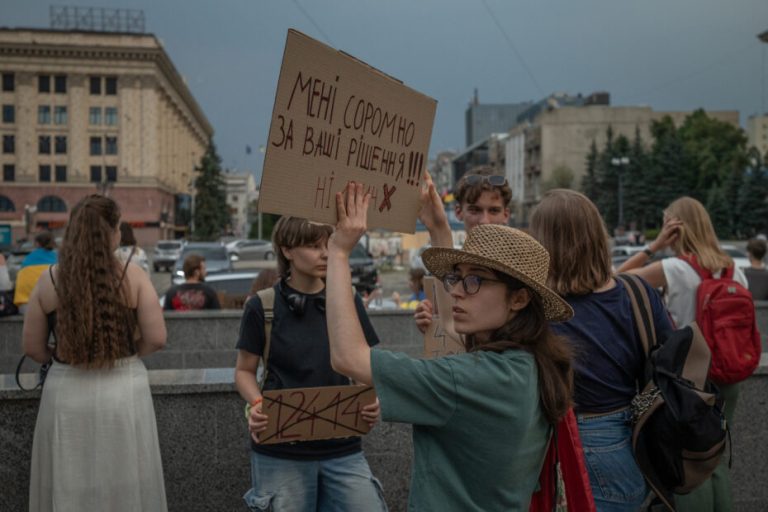Ukraine’s Anti-Corruption Protests: A Target for Russian Disinformation
In July 2025, a wave of protests swept across Ukraine following the passage of bill #12414, which limited the independence of key anti-corruption bodies, NABU and SAPO. Despite widespread calls for a veto, President Zelenskyy signed the bill, sparking public outcry and providing fertile ground for Russian disinformation campaigns. Ukraine’s intelligence agency, HUR, warned of Russia’s potential exploitation of the situation to destabilize the country and erode its resilience amidst the ongoing war. The protests, driven by genuine concerns over democratic backsliding and the fight against corruption, quickly became a target for manipulation by pro-Kremlin media and online sources. These actors sought to distort the narrative, framing the protests as evidence of internal division and dissatisfaction with Zelenskyy’s leadership, rather than a defense of anti-corruption efforts.
The Kremlin’s disinformation machinery rapidly mobilized, leveraging a network of anonymous Telegram channels, pro-Russian media outlets, and social media accounts to spread manipulative narratives. Anonymous Telegram channels like “Legitimate,” “Residents,” and “ZeRada” propagated messages portraying Zelenskyy as a dictator and the protests as a sign of burgeoning popular rebellion. Simultaneously, English-language platforms like The Gateway Pundit, Redacted, InfoBrics, and The Grayzone echoed these sentiments, amplifying the narrative of Ukraine’s descent into authoritarianism. These narratives were further disseminated through social media accounts like Russian Market, AmericaPapaBear, and UkraineTruthDaily, often accompanied by manipulated videos of the protests and hashtags like #ZelenskyDictator and #UkraineProtests. These coordinated efforts sought to manufacture an image of widespread anti-Zelenskyy sentiment and exploit legitimate concerns for malicious purposes.
One of the main disinformation narratives revolved around falsely characterizing the protests as solely directed against Zelenskyy, obscuring the true focus on preserving the independence of anti-corruption institutions. Pro-Russian channels employed inflammatory language, describing Zelenskyy’s “fear” and depicting the protests as a “new Maidan,” invoking imagery of previous revolutions. This strategy aimed to sow distrust in the government and undermine its legitimacy. Another prominent narrative falsely claimed that Western media was deliberately ignoring the protests, suggesting a conspiracy to suppress dissent. This claim was amplified through social media posts alleging a NATO “ban” on coverage, despite the fact that major outlets like BBC and CNN did report on the events. This tactic attempted to discredit Western media and foster the perception of a biased narrative.
Furthermore, pro-Russian sources attempted to hijack the protests by portraying them as calls for peace with Russia, exploiting the “war fatigue” narrative. This disinformation campaign received a boost from figures like US Congresswoman Marjorie Taylor Greene, who amplified pro-Russian talking points, framing the protests as evidence of Ukrainian opposition to the war and Zelenskyy’s supposed refusal to negotiate peace. Greene’s statements, which aligned with existing Kremlin propaganda, further fueled the false narrative of widespread Ukrainian desire for peace at any cost. The narrative of Ukraine as a dictatorship under Zelenskyy became another focal point of the disinformation campaign. Social media accounts, particularly on X (formerly Twitter) and TikTok, circulated messages accusing Zelenskyy of cracking down on dissent and suppressing protests. This narrative targeted international audiences, particularly in the UK and the US, aiming to erode trust in Ukraine and its leadership among its allies. Gwara Media debunked specific instances of fabricated news, such as the false claim that an activist was charged with animal cruelty for bringing a dog with a sign critical of Zelenskyy to a protest.
The Institute for the Study of War (ISW) highlighted the Kremlin’s strategic use of these protests to advance pre-existing narratives about Ukrainian government corruption and illegitimacy. By falsely associating the protests with opposition to the war effort, Russian propagandists sought to undermine Western support for Ukraine and create a distorted perception of internal discord. The disinformation campaign extended to undermining trust in Ukraine’s reform process, crucial for its EU accession aspirations. Pro-Russian sources portrayed the protests as evidence of failed anti-corruption efforts and dictatorial leadership, aiming to sow discord and discourage necessary reforms. However, the EU itself reiterated the importance of these reforms and the independence of anti-corruption institutions, aligning with the protesters’ actual concerns rather than the manipulated narratives.
Ultimately, the Kremlin sought to exploit internal Ukrainian events to create a false image of chaos and instability, aiming to weaken international support and discredit the Ukrainian government. Oleh Ivashchenko, head of Ukraine’s Foreign Intelligence Service, emphasized the importance of maintaining societal unity and resisting Russian attempts to sow division, both domestically and on the international stage. The disinformation campaign surrounding the anti-corruption protests exemplifies Russia’s ongoing efforts to manipulate information and undermine Ukraine’s resilience in the face of aggression. The false narratives pushed by pro-Kremlin sources demonstrate the need for critical media literacy and the continued exposure of disinformation campaigns.


